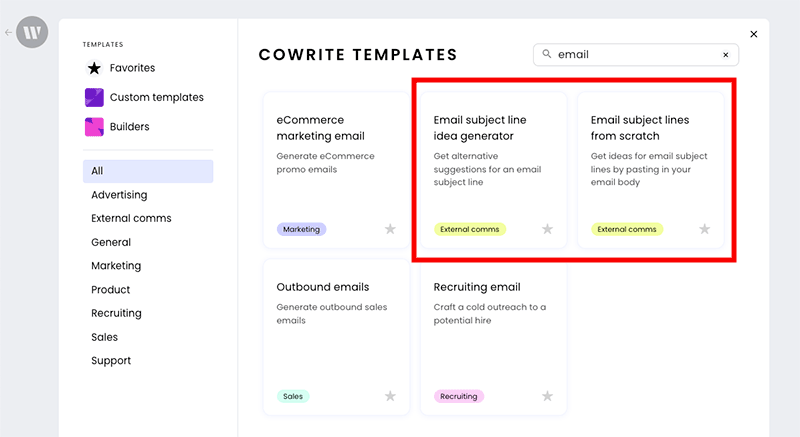You may be the most creative email marketer or writer ever. But after a while, continuously creating new and catchy subject lines can get tedious. That’s especially true if you’re sending a lot of emails daily.
But, if you don’t do well on your subject lines, you might experience poor open rates. So what can you do to avoid being burnt out but still get some good subject lines to entice readers to open your email?
That’s where using artificial intelligence (AI) comes in. AI tools can help you produce subject lines faster and ensure you’re keeping things fresh and high quality.
In this blog, we’ll explore why email subject lines are important, the best practices for writing them, and how AI can help you.
Why do email subject lines matter?
As any email marketing agency will tell you, the first thing the email recipient sees is the subject. Think of your subject line as the first impression during a date. Your recipient will have a perception of your brand — whether good or bad — based on that.
It doesn’t matter how well your email is written, or how powerful your call-to-action is at the end. If the recipient doesn’t find your subject line intriguing enough, your email will not be opened. Worse, if you have a bad subject line, they might send your email to their spam folders!
In short: want to avoid being marked as spammy and improve your open rates? Writing better subject lines goes a long way.
How can AI help you with email subject lines?
So how does AI help you write better? How does an AI writing tool work, anyway? Here’s a short explanation.
AI works by using natural language processing (NLP) and machine learning algorithms. To get it started, the makers of the tool feed it a large amount of data on email engagement. The AI can then identify the markers or patterns that lead to higher open email rates. Some of these factors include the length of the subject line, the tone, the phrasing, and so on.
From there, when you use the tool, it can suggest and generate effective subject lines. It will draw on the data that it was given and generate subject lines that work while avoiding ones that didn’t or may be considered spammy. It can even help with personalization and other things that you’d rather automate instead of doing everything yourself.
That will help you save effort and time and can also help improve any email campaign you’re running.
Do I leave everything up to the AI tool?
AI might make your life easier in writing email subject lines, but it’s not recommended to let it do everything. For one thing, the lines that the tool generates might not necessarily be your brand voice. Remember, AI tools are meant to help write faster based on data, not on knowledge about your brand.
So as soon as the tool has generated some lines you can use, make sure to read each one carefully. Don’t just plug it into your emails and click send. Edit it so that it still sounds like your brand and won’t turn off your customers.
Also, do what email marketers call A/B testing or split testing. That involves using a few subject lines and then sending them to small sample groups. From there, you’ll compare the results and use the best-performing one on your list of subscribers.
By doing split testing, not only will you find out your best subject lines, but you’ll also get more data which you can feed into your AI tool. That will help it improve the next time you use it.
Email Subject Lines Best Practices
Even as you use AI to make your email subject line writing easier, make sure to keep these best practices in mind:
- Personalize the lines. It helps if your subject feels like you are directly talking to them, instead of a generic audience. Include their first name — you’ll feel the difference in open rates.
- Be direct. It’s tempting to try and be mysterious all the time. However, it’s better if you get straight to the point and talk about what you’re selling and how it benefits the reader.
- Keep the subject line short. It’s best to keep the subject line in 7-10 words or 60 characters. That way, it won’t be cut off even for people reading from their mobile phones.
- Limit using emojis. Emojis are cute and can be eye-catching. However, limit the use, as it can give off the impression that your brand is unprofessional. It’s also tempting to use one instead of a word, but your recipient may not understand it.
- Use fewer punctuation marks. Too many punctuation marks in the subject line might get your email marked as spam. Use a maximum of 3.
- Check grammar and spelling. Another way to get marked as unprofessional and spammy is if your subject lines have the wrong grammar and spelling. Double-check this part before pressing send.
What AI tools should you use to generate email subject lines?
AI tools for generating email subject lines are aplenty nowadays, so which one should you use? Well, it ultimately depends on your goal, your budget, and ease of use. Here are some AI tools you can check out to get started.
Writer AI
We’ll kick things off with Writer as it’s one of the AI content generation platforms that not only has some ready-made templates for generating email subject lines, but it also has a seamless integration with DivvyHQ. With Writer, you can choose between two templates that can either help you craft email subject lines from scratch, or it can provide alternatives for an existing subject line.
Jasper
Jasper is an AI copywriting tool that generates email subject lines based on your company’s name, product, tone of voice, and what your email is about. Aside from that, you can also generate search-optimized and original content. It also houses multiple templates for writing other things like product descriptions, landing pages, and more.
It has a free trial, so you can play around with it before deciding to opt-in. Jasper also works flawlessly right inside of DivvyHQ.
ChatGPT
ChatGPT is a language model developed by OpenAI and fed with data and techniques to get human-like text subject lines. Using this program is simple: just enter a prompt about the email subject lines you want, and it will generate a lot for you.
However, it can be quite limited and frustrating if you don’t know what prompts to use. It might take you a few tries before you get what you’re looking for.
It has free and paid versions. The problem with the free version is that it can get overloaded by many people using it all at once.
Copy.ai
Just like Jasper, Copy.ai can also generate not just email subject lines but also social media captions, blogs, and so on. To get your email subject line, enter your brand name, product description, and tone of voice (you can choose from 9!). Unlike Jasper, Copy.ai has a free forever option, although it’s limited to the generation of 2000 words monthly.
Encharge
Encharge is a free email subject line generator. Just enter some context about your email, your company name, and the tone of voice, and the tool will generate seven lines. If you’re not convinced, just keep pressing the “Generate” button until you get the result that you want.
Encharge is very easy to use, making it a very attractive option for those who aren’t convinced about investing in AI tools just yet.
ActiveCampaign
ActiveCampaign is the only email marketing software on this list, so it might be one of the best ones to use so you can send emails directly. It’s simple to use — follow the instructions and you’ll get 4 suggestions, with more available by just clicking “Generate more”. What it does lack, though, is the ability to adhere to the tone of voice you’re going for.
Final Thoughts
Writing effective email subject lines is important in getting your recipients to open and engage with your emails. Using AI tools for email subject lines can save time and effort while improving your email marketing campaign’s performance. By incorporating these content automation tools and best practices, you can create subject lines that click with your audience and boost your open rates.
For more great tips, tricks, and how-to’s, subscribe to the DivvyHQ blog today!

